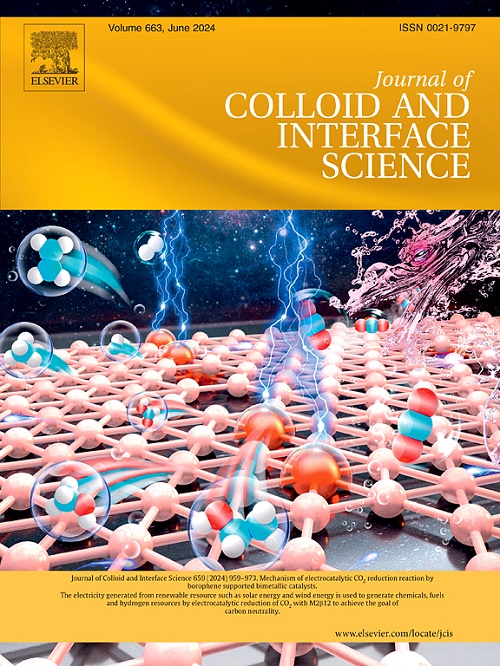Transitions in intra-droplet flow and wetting governing nanoparticle deposition patterns in inkjet-printed nanofluids
IF 9.7
1区 化学
Q1 CHEMISTRY, PHYSICAL
引用次数: 0
Abstract
Hypothesis
The deposition patterns of nanoparticles from evaporating inkjet-printed nanofluid droplets are determined by transitions in intra-droplet flow and wetting dynamics. These transitions are continuous and can be systematized when accurate measurement techniques, systematic samples, and appropriate dimensionless numbers are used.
Experiments
This study investigated the roles of the Péclet number (Pe), Marangoni number (Ma), and the dimensionless evaporation rate ratio () in the wetting dynamics and formation of nanoparticle deposition patterns. Using phase-shifting imaging ellipsometry, droplet shapes were measured with nanometer to micrometer precision, enabling the correlation of wetting dynamics with deposition patterns and accurately capturing their transitions.
Findings
The experiments demonstrated that deposition patterns—such as coffee rings, multi rings, spokes, and uniform films—emerge from specific intra-droplet flow and wetting dynamics. A high Pe, indicating dominant convective transport over diffusion, favors pronounced coffee ring patterns, whereas a low Pe results in more uniform deposition. Results showed that Marangoni–Bénard convections dominated at critical Ma values, whereas stick-slip motion governed the multi ring formation under low . These findings establish a predictive framework for tailoring the deposition patterns in inkjet-printed nanofluids. Furthermore, the high-precision measurements enabled new experimental observations, including the observation of larger spreading than pure liquids and coffee ring formation within nanoliquid films.

喷墨打印纳米流体中控制纳米颗粒沉积模式的液滴内流动和润湿的转变
假设蒸发喷墨打印纳米液滴的纳米颗粒沉积模式是由液滴内部流动和润湿动力学的转变决定的。这些转变是连续的,当使用精确的测量技术、系统的样本和适当的无因次数时,可以将其系统化。实验研究了passiclet数(Pe)、Marangoni数(Ma)和无量纲蒸发速率比(τre/τev)在纳米颗粒润湿动力学和沉积模式形成中的作用。利用相移成像椭偏仪,以纳米到微米的精度测量液滴形状,实现了润湿动力学与沉积模式的关联,并准确捕获了它们的转变。实验表明,沉积模式——如咖啡环、多环、辐条和均匀薄膜——来自于特定的液滴内部流动和润湿动力学。高Pe,表明对流输运优于扩散,有利于明显的咖啡环模式,而低Pe导致更均匀的沉积。结果表明:在临界Ma值下,以marangoni - bsamuard对流为主,而在低τre/τev条件下,以粘滑运动为主。这些发现为调整喷墨打印纳米流体的沉积模式建立了一个预测框架。此外,高精度测量实现了新的实验观察,包括观察到比纯液体更大的扩散和纳米液体膜内咖啡环的形成。
本文章由计算机程序翻译,如有差异,请以英文原文为准。
求助全文
约1分钟内获得全文
求助全文
来源期刊
CiteScore
16.10
自引率
7.10%
发文量
2568
审稿时长
2 months
期刊介绍:
The Journal of Colloid and Interface Science publishes original research findings on the fundamental principles of colloid and interface science, as well as innovative applications in various fields. The criteria for publication include impact, quality, novelty, and originality.
Emphasis:
The journal emphasizes fundamental scientific innovation within the following categories:
A.Colloidal Materials and Nanomaterials
B.Soft Colloidal and Self-Assembly Systems
C.Adsorption, Catalysis, and Electrochemistry
D.Interfacial Processes, Capillarity, and Wetting
E.Biomaterials and Nanomedicine
F.Energy Conversion and Storage, and Environmental Technologies

 求助内容:
求助内容: 应助结果提醒方式:
应助结果提醒方式:


